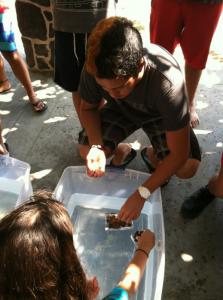
Native Hawaiian students get hands on hydrology lessons in prep for marine debris experiment. Photo courtesy of http://manoa.hawaii.edu
By Staff Reports
(Honolulu)– In partnership with UH Mānoa’s Kua’ana Native Hawaiian Student Development Services, twenty Native Hawaiian middle and high school students from the Nā Pua No’eau Center for Gifted and Talented Native Hawaiian Children will conduct a shoreline experiment as part of Mālama ‘Āina Marine Debris Research Pathways (MAMDRP). MAMDRP, which aims to promote science learning opportunities for Native Hawaiians, pairs students with UH Mānoa mentors.
As part of the program, the students are spending nine months investigating why debris from the Japan tsunami is washing up on Hawai’i shores and where exactly it is happening. In December, MAMDRP will feature two public marine debris experiments where Nā Pua No’eau students will use the “living laboratory” of two shoreline locations;
· December 1, 2012, 9:30 a.m. Windward side outside of He‘eia Keia Boat Harbor
· December 8, 2012, 9:30 a.m., Leeward side outside of Wai‘anae Boat Harbor
(Note: Media is welcome to attend and photograph the event. Interviews may be conducted at the end of the event at approximately 11:00 a.m. If attending, please notify Kinohi Gomes at 956-9410 in advance.)
These two experiments highlight the MAMDRP curriculum that is developed and taught by mentors, who are Native Hawaiian undergraduate and post baccalaureate students at UH Mānoa studying towards degrees in various disciplines of science. With scientific inquiry and traditional Hawaiian methods of ocean way-finding, mentors guide the students through the process of determining how ocean currents affect the flow of marine debris at specific sites on O’ahu.
As part of the demonstration, students and mentors will release and track 1,600 wooden floaters-a proxy for marine debris–into the ocean from different locations. One group of students and mentors will track the faux debris aboard the traditional Hawaiian sailing canoe known as Kanehunamoku, considered a “granddaughter” of Hōkūle’a; others will observe and record the experiment outcomes from pre-determined sites; some students will also conduct related land-based activities.
Using various scientific data gathering tools and methodologies, the students will compare results to their earlier predictions that they calculated with the help of MAMDRP lessons in ocean currents and principles of hydrology such as density, a factor that plays a major role in marine debris dispersion. Students will also assist in incorporating the data into a final MAMDRP report that they will present at a UH Mānoa conference, providing them the opportunity to reach a larger audience.
As part of MAMDRP, students conduct research on problems linked to worldwide increases in marine debris caused by nature and human activity. Students are also learning about cultural components that span Hawaiian language, history and protocol connected to specific O’ahu shoreline sites that have been the focus of MAMDRP.
“A key component of MAMDRP is the UH mentors, who exemplify great enthusiasm for their chosen fields of science, while impressing on the middle and high school students the importance of gaining the academic skills to properly protect our natural resources in perpetuity, as our Hawaiian culture also directs us to do,” said Kinohi Gomes, Director of Operations at Nā Pua No’eau Center for Gifted and Talented Native Hawaiian Children.
A main goal of MAMDRP is to encourage more Native Hawaiians to enter science studies and related research professions in the academic, public and private sectors, where there is an increased demand for local expertise but where Native Hawaiians have historically been underrepresented. Kua’ana Native Hawaiian Student Development Services and Nā Pua No’eau work to raise the educational and career aspirations of Hawaiian students and their families. The MAMDRP Pathways program provides a continuum of programs as a pathway to higher education, while also forging lasting connections to Kanaka Maoli cultural practices and values. Inquiries about Nā Pua No’eau should be directed to: http://npn.uhh.hawaii.edu.
Kua’ana Native Hawaiian Student Development Services is program of the UH Mānoa Office of Student Equity, Excellence and Diversity (SEED). SEED is committed to building a supportive community in which traditionally underrepresented groups who come to UH Mānoa are encouraged in their intellectual pursuits and long-term professional goals.
For more information on Kua’ana Native Hawaiian Student Development Services: http://www.hawaii.edu/diversity.
